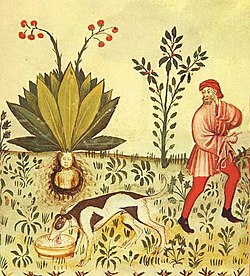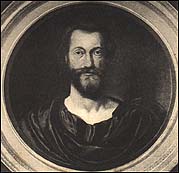Annick Goutal Mandragore: decoding the witchy mystique
I know this is old news for a lot of you, but I need to get my two cents in on everything, so I’m going to tell you what I, la Bonne Vivante, think of Annick Goutal’s Mandragore. First of all, this is an awesome name, conjuring images of village wise women pounding down mandrake roots in mortars and pestles, aphrodisiac concoctions containing dangerous ingredients like belladonna, hensbane, and mandrake, and metempsychosis, the movement of a soul from one entity to another. And, of course, now the Harry Potter books, where Rowling uses the traditional folklore of the screaming root to great effect. My favorite literary reference to mandrake next to its use in the Old Testament to imply sexual intercourse (see the Song of Songs and Genesis 30) is the Great John Donne’s poem of impossibilities:
Go and catch a falling star,
Get with child a mandrake root,
Tell me where all past years are,
Or who cleft the Devil’s foot;
Teach me to hear mermaids singing,
Or to keep off envy’s stinging,
And find
What wind
Serves to advance an honest mind.If thou be’st born to strange sights,
 Things invisible to see,
Things invisible to see,
Ride ten thousand days and nights
Till Age snow white hairs on thee;
Thou, when thou return’st, wilt tell me
All strange wonders that befell thee,
And swear
No where
Lives a woman true and fair.
If thou find’st one, let me know;
Such a pilgrimage were sweet.
Yet do not; I would not go,
Though at next door we might meet.
Though she were true when you met her,
And last till you write your letter,
Yet she
Will be
False, ere I come, to two or three.
SO at first sniff, Annick Goutal’s Mandragore is disappointing, not as dark or mysterious as we may have expected, based on the perfumer’s description of the offering. It is actually a very well-behaved cologne type. I get a very lovely bergamot/cardamom topnote, followed quickly and intensified by an accord of bitter herbs and anise. It dries down to a watery purple lavender/violet/tea accord, to my nose, with some ginger and wood thrown in for good measure. No hint of black magic at all, unless you count the earthy greenness of the juice as a whole. And that, I think, is the secret to Mandragore. This is not a fragrance for wannabe witches; it is a fragrance for bookish people. Hence the Earl Grey notes, the old-fashioned cologne factor, the obscure ingredient, the antique looking bottle. And, if one thinks about it in those terms—as a love letter to book
 s and the obscure information found in them—this juice makes perfect sense.
s and the obscure information found in them—this juice makes perfect sense.And that brings us full circle to the mandrake. If we think about the mandrake as a study in miniature of the joys of folklore, of a type of mind that looks backwards instead of forwards, not just as a witchy ingredient, the meaning of Goutal’s fragrance becomes much clearer. This is a love letter to the obscure, the bookish and the quaint.
The monstrous and phallic elements of the Mandrake’s folklore—like it only grows where the semen of a hanged man has dropped (gross), the fact that it looks like, depending on the folklore you consult, a little man (homunculus) or a penis, or the basic fact that it is a psychotropic drug whose every part is in some way poisonous—are significantly left uninterpreted here. The depth and mystery of this fabled plant simply must await some perfumer with a really dark imagination to give it voice. I know that it is considered to have an aphrodisiac effect, but cannot vouch for that property here with Mandragora; what I get is a very nice but quite tame herbal cologne.
h



Comments
Post a Comment
what thinkest thou?